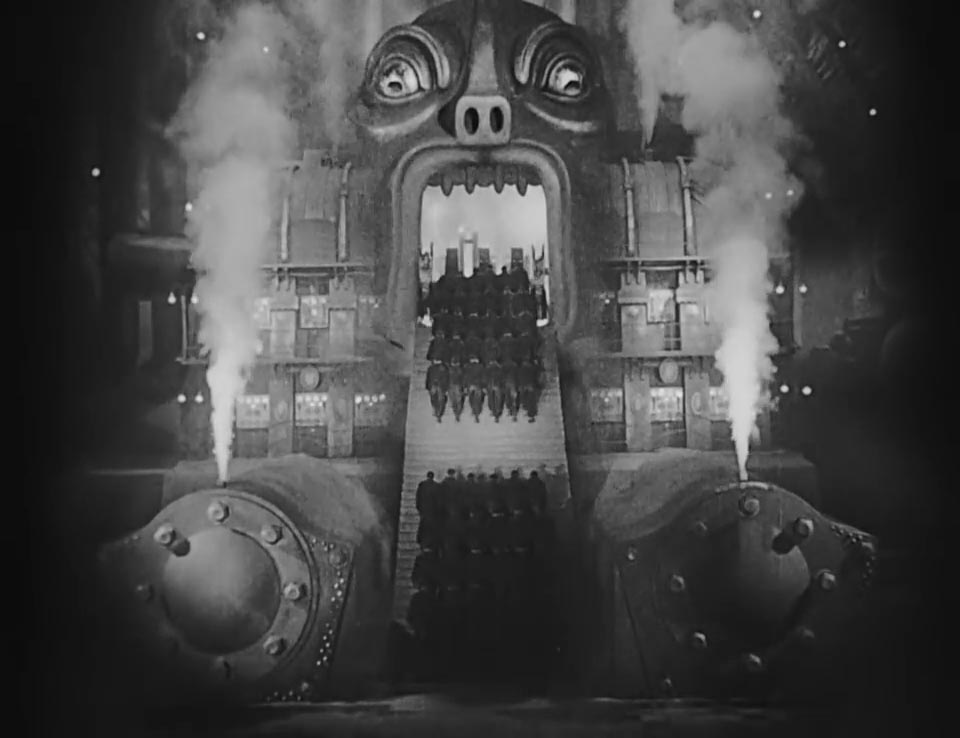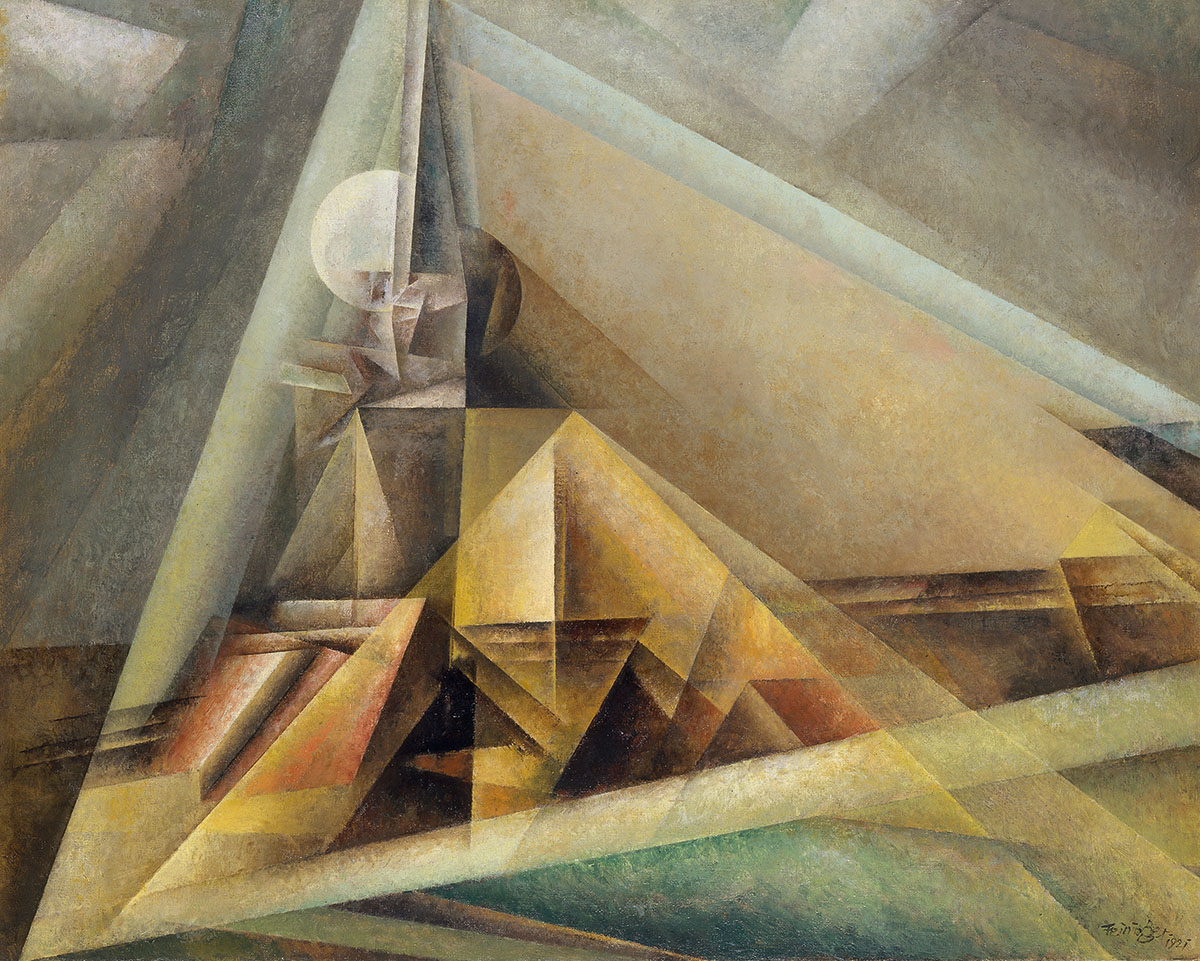Metropolis (1927) is seen by some critics as the last major Expressionist film. Indeed, there are stylistic and thematic similarities – for example in terms of image composition, decor, drama and specific sub-themes, such as the father-son relationship, human-machine conflict and class-based society. On the other hand, Fritz Lang does depart from Expressionism when it comes to cinematic aesthetics and the architecture depicted. Light and shadow are used as stylistic and structural elements to emphasis social contrasts – the masses in the subterranean city follow a certain choreography which, in combination with the rhythm of the cuts, helps create a new spatial geometry. Above all, it is the architecture of the above-ground city – a nod towards the skyscrapers of the US – whose visionary power still influences the genre:
“Metropolis stands out clearly from the phantastical films of the silent film era and in Germany established a new film genre: science fiction. Aspects which were then truly innovative are today prevalent patterns in the modern-day genre. The exposition lays bare a dystopian, class-based society: workers are housed like slaves in an underground city and work ten hours a day in front of a tyrannical machine, while the people in the upper city enjoy lives of luxury and excess.” (Töteberg 1989, 53)1
Visual codes, such as the play of shadows and vertically-framed scenes, were used by Fritz Lang to shift the focus onto the skyscrapers and were incorporated later into Film Noir as stylistic elements in their own right. Many motion pictures from the Film Noir movement draw thematically on Expressionist interpretations of cities, which then acts as a psychology sub-structure for the broken anti-heroes of the American post-war period (see Filmportal.de).
 Metropolis: The Moloch Machine (Still frame)
Metropolis: The Moloch Machine (Still frame) 
Erich Kettelhut was responsible for the stage design. The architecture of the mechanical underground city uses a motif from an etching by Franz M. Jansen in 1921: “Two etchings from Franz Maria Jansen’s 1921 portfolio Industry capture a dehumanizing urban landscape of factories billowing smoke and cavernous rows of machines through which workers trudge mechanically, very much as they are portrayed returning from work in Metropolis.” (Benson 2012)
The above-ground city was modelled on works by the Bauhaus artist, Lyonel Feininger, amongst others. Born in New York, he travelled to Berlin in 1888 where he studied at the Royal Academy: “Here he experienced the rapid changes in the city, the creation of an architecturally representative centre ringed by tenements, embodying the crass social divisions of Wilhelmine society. In Feininger’s woodcut, ‘Kathedrale des Sozialismus’, which appeared as the frontispiece of the Bauhaus manifesto in 1919, the linear city of urban modernity is devoid of the dissonant notes of social and class conflicts, but instead symbolizes a modern urban utopia in which social relations would be organically harmonious (…).” (McElligott 2001, 36)
 Lyonel Feininger: Villa on the Shore IV, 1918
Lyonel Feininger: Villa on the Shore IV, 1918 
Stylistically, the Babel sequence in Metropolis resembles two paintings created by Feininger. Villa on the Shore IV painted in 1918 in Heringsdorf, Germany. This woodcut, influenced by Expressionism, reduces the motif to an abstract geometric composition in which only the villa with its horizontal and vertical elements has a sense of a material presence. On the other hand, the foreground and, above all the sky, make use of the interplay of diagonal lines and expanses in black and white to achieve its dynamic impact.
 Lyonel Feininger: Gaberndorf I, 1921
Lyonel Feininger: Gaberndorf I, 1921 
The coloration of the Metropolis sequence is based on Gaberndorf I (1921). Featuring stylistic traits of the Heringsdorf woodcuts, this oil painting was also influenced by Cubism. The colours chosen by Feininger were earthy tones in a variety of nuances in saturation. The radial arrangement of the picture’s geometry shows light as if it were being passed through a prism.
1 Original quote: „Metropolis hebt sich deutlich ab vom phantastischen Film der Stummfilmära und begründete in Deutschland ein neues Filmgenre: die Sciencefiction. Die damals neuartigen Elemente gehören heute zu den gängigen Mustern der Gattung. Eine negative Utopie zeigt die Exposition; der Zukunftsstaat ist eine Klassengesellschaft: Während in der achtlosen Unterstadt die Arbeiter wie Sklaven hausen und zehn Stunden am Tag von der Maschine tyrannisiert werden, leben die Menschen der Oberstadt in einer Welt des Luxus und des Überdrusses.“
Filmportal.de: Fritz Langs „Metropolis“ im Wandel der Zeit. O.D.
URL: http://www.filmportal.de/thema/fritz-langs-metropolis-im-wandel-der-zeit (accessed October 2016)
McElligott, Anthony: The German Urban Experience, 1900-1945: Modernity and Crisis. London / New York 2001.
Benson, Timothy: Metropolis, Dr. Caligari, and the Aesthetics of Expressionist Cinema. Los Angeles 2012.
URL: http://unframed.lacma.org/2012/10/11/metropolis-dr-caligari-and-the-aesthetics-of-expressionist-cinema (accessed October 2016)

